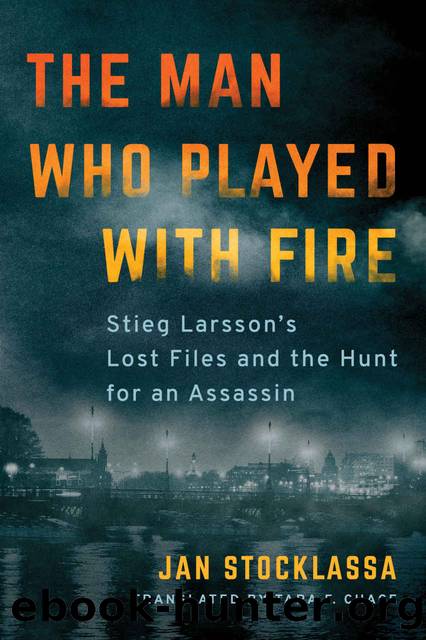The Man Who Played with Fire: Stieg Larsson's Lost Files and the Hunt for an Assassin by Jan Stocklassa

Author:Jan Stocklassa [Stocklassa, Jan]
Language: eng
Format: azw3
Published: 2019-09-30T16:00:00+00:00
To the Archive
Stockholm, March 2012–March 2013
After my meeting with Anna-Lena, I met with several of Stieg’s friends and coworkers, who gave me their impressions of Stieg and his work. Sometimes I stopped and asked myself if it was worth all the time I was putting into digging up new leads, since I wasn’t even writing a book anymore. The answer was always no, but I kept going anyway. The mystery of Stieg and the Palme assassination became my escape, my obsession.
In our conversation, the journalist Håkan Hermansson described working on the book Mission: Olof Palme (Uppdrag: Olof Palme) and confirmed Stieg’s unbelievable research skills, how they had mapped out the intense opposition to Palme, and how Stieg had been researching the assassination on the side.
Sven Ove Hansson, the patriarch when it came to mapping out Swedish extremism, had worked with Stieg and confirmed to me the image of him as a supremely gifted researcher. Hansson was also the one who had connected Stieg to both Håkan Hermansson and Anna-Lena Lodenius.
Tobias Hübinette, who was the research director for and one of the founders of the antiracist magazine Expo, said that among other things, Stieg had collected letters that Anders Larsson had written to various people, including Cabinet Secretary Pierre Schori. He told me that the letters and a number of other things could be found at Expo’s offices or possibly with Eva Gabrielsson.
Stieg’s girlfriend Eva was kind enough to agree to meet with me on several occasions. Our conversations often slid into our shared interest in architecture, but every now and then we talked about Stieg. She said that the line of inquiry Stieg believed in most was the one based on South African agents and Swedish right-wing extremists. But she didn’t have any of Stieg’s material about the Palme assassination.
I was tremendously disappointed to find out that Stieg believed in a big conspiracy involving the South African security services. That didn’t fit with my theory of Alf Enerström being the killer, with the help of one or two other people.
Daniel Poohl, editor in chief of Expo, explained that Stieg had still been interested in the Palme assassination when they started working together in 2001. He also mentioned that Expo had some papers at a storage facility that might be relevant. It took another few days before he got back to me. We decided we would meet the next morning in the parking lot outside the storage facility where the boxes containing Stieg’s papers were stored. It started snowing heavily that night.
Download
This site does not store any files on its server. We only index and link to content provided by other sites. Please contact the content providers to delete copyright contents if any and email us, we'll remove relevant links or contents immediately.
What's Done in Darkness by Kayla Perrin(25501)
Shot Through the Heart: DI Grace Fisher 2 by Isabelle Grey(18220)
Shot Through the Heart by Mercy Celeste(18160)
The Fifty Shades Trilogy & Grey by E L James(17777)
The 3rd Cycle of the Betrayed Series Collection: Extremely Controversial Historical Thrillers (Betrayed Series Boxed set) by McCray Carolyn(13189)
The Subtle Art of Not Giving a F*ck by Mark Manson(12912)
Scorched Earth by Nick Kyme(11833)
Stepbrother Stories 2 - 21 Taboo Story Collection (Brother Sister Stepbrother Stepsister Taboo Pseudo Incest Family Virgin Creampie Pregnant Forced Pregnancy Breeding) by Roxi Harding(11040)
Drei Generationen auf dem Jakobsweg by Stein Pia(10217)
Suna by Ziefle Pia(10186)
Scythe by Neal Shusterman(9263)
International Relations from the Global South; Worlds of Difference; First Edition by Arlene B. Tickner & Karen Smith(8609)
Successful Proposal Strategies for Small Businesses: Using Knowledge Management ot Win Govenment, Private Sector, and International Contracts 3rd Edition by Robert Frey(8419)
This is Going to Hurt by Adam Kay(7696)
Dirty Filthy Fix: A Fixed Trilogy Novella by Laurelin Paige(6453)
He Loves Me...KNOT by RC Boldt(5805)
How to Make Love to a Negro Without Getting Tired by Dany LaFerrière(5378)
Interdimensional Brothel by F4U(5305)
Thankful For Her by Alexa Riley(5162)
